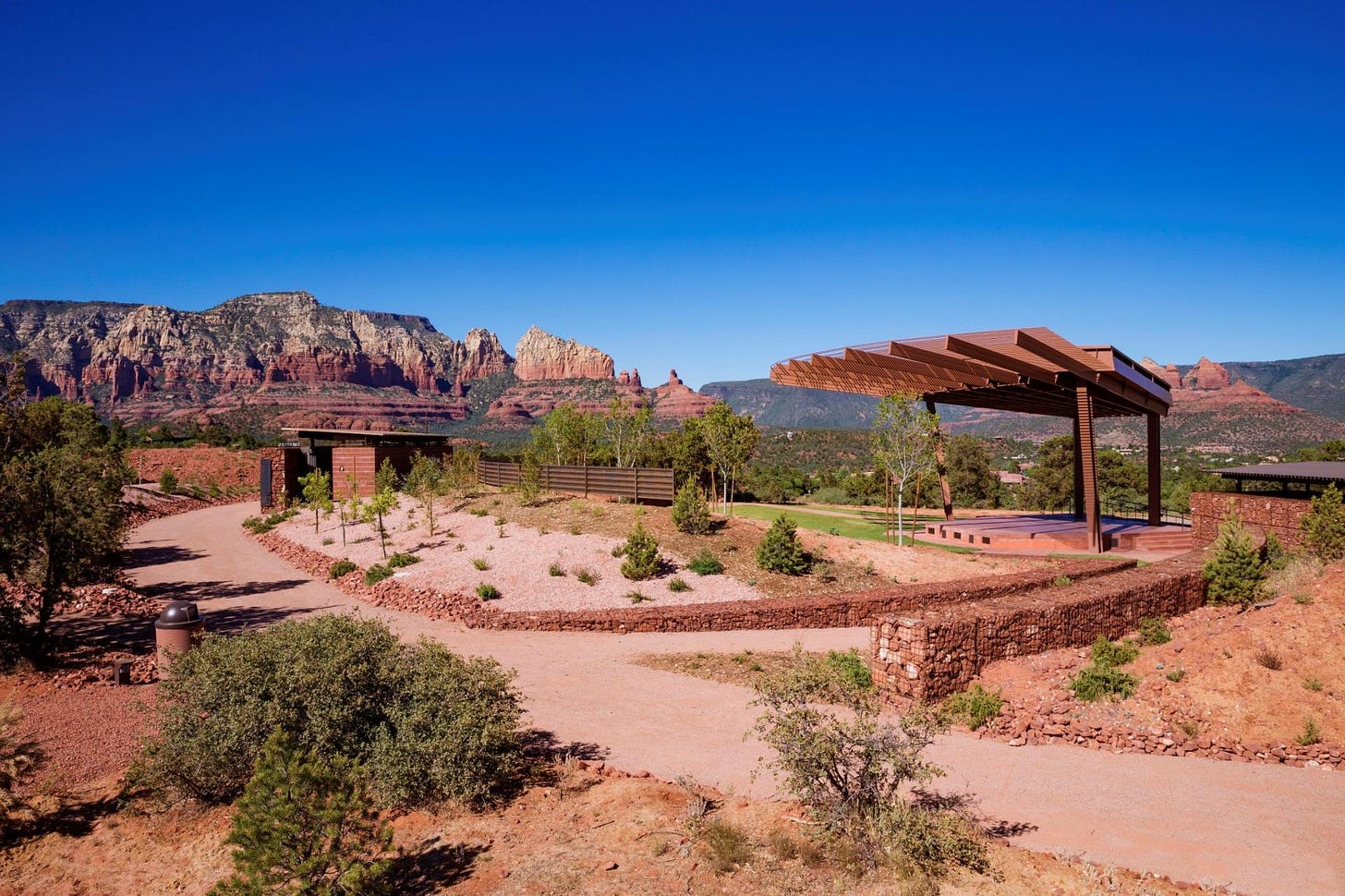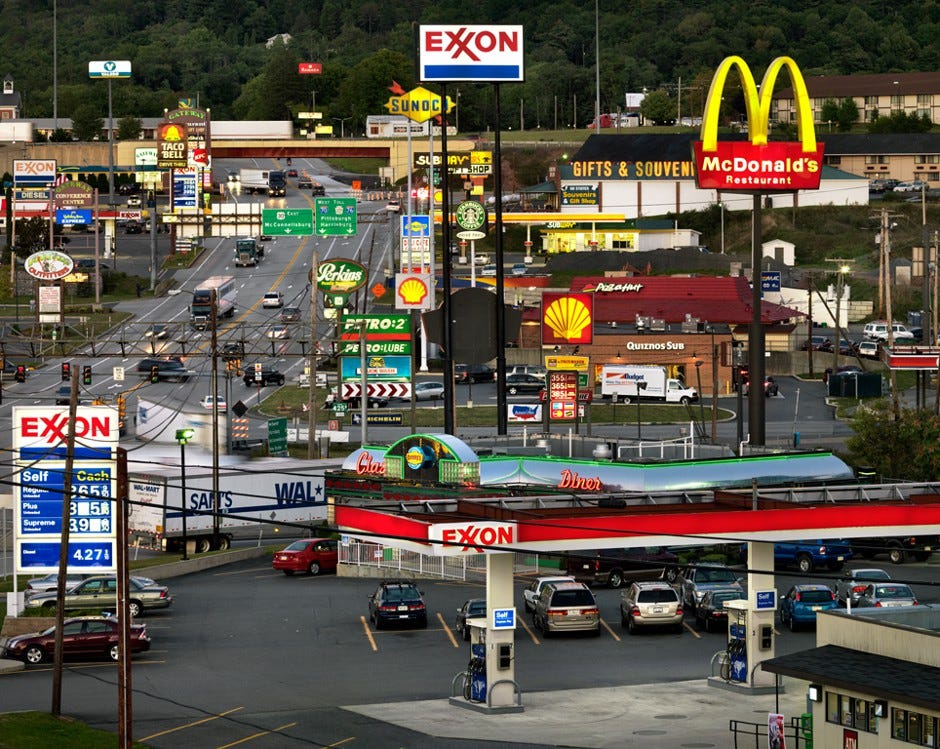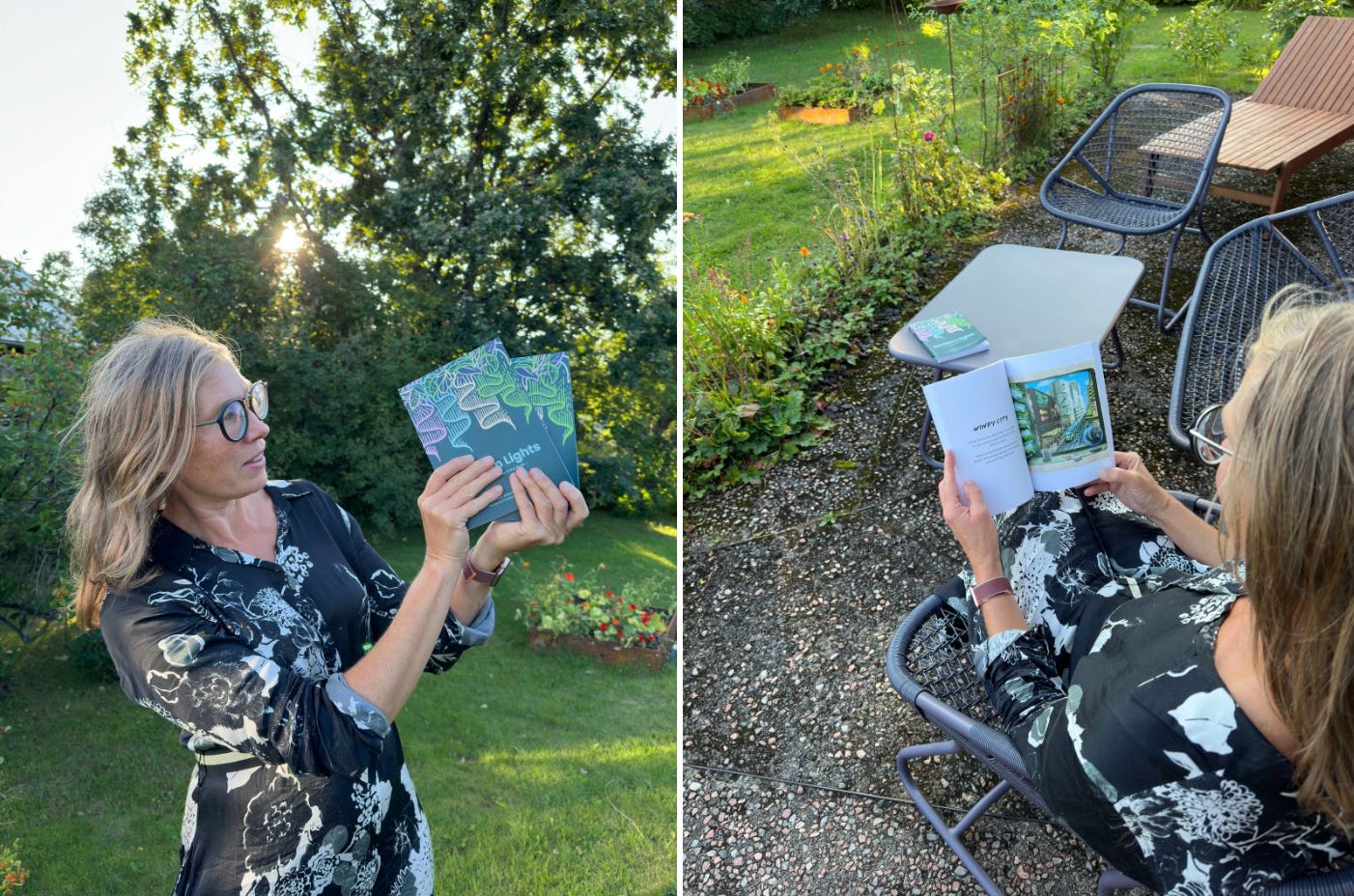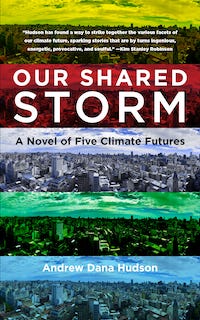Solarshades was off last month due to being in the woods and general life chaos. Part of that chaos involved a bout of car trouble in the mountains north of Sedona, on our way to our annual Colorado camping trip. We limped our aging Nissan into Flagstaff, where we got the terminal news about the transmission. So we needed a new car, and decided to look at the used EVs the dealership had in stock. In the end we got a very good condition 2019 Chevy Bolt.
We’d been talking about getting an EV for a while — there’s zero non-financial justification for buying a fossil vehicle in 2024. I’m a relatively high information consumer when it comes to the energy transition, but still the process of switching from gas to electric took some adjustment.
Perhaps ambitiously, we tried to catch up with our Colorado itinerary, figuring we might as well just jump into the deep end of the pool. We did our first fast charge at a Gallup Walmart Supercenter, stopping for lunch at the McDonalds inside. There we discovered, after several frustrating attempts, that successfully connecting to an Electrify America fast charger required manually holding the too-heavy charger flush to our car until it fully paired and began charging. (Thank you Reddit for this secret trick.) Thankfully, we also discovered that you meet the absolute nicest, most helpful people at the charger. Probably this is because, well, frankly, people who buy EVs are more likely to be conscientious liberals who take pride in such niceness. But also there’s a sense of tribal mutual benefit: the more easily new EV drivers can get through this learning curve, the more of us there will be, and the more charging infrastructure will be built in response.
We did our next top-up in the back lot of a Buick dealership in Farmington, hanging out in their air conditioned lounge. It was at this point that we decided we weren’t going to catch up with our whole Colorado itinerary. Mostly this was because we were two days behind, and 12 hour driving days seemed a lot less fun than 5 hour ones. But I must admit that range anxiety played a part, as did the general friction the new car added to the trip. Our dashboard reported on our second-by-second efficiency, so we drove slower to maximize the mileage of our charge. And since we had opted for a used 2019 model instead of a more expensive new one, we were unable to get the ultrafast/hyperfast charge speeds that make it possible to fill up with a 15 minutes bathroom break, instead of a 45 minute lunch. Our trip had been planned for a gas car, and that was no longer what we were driving.
It all worked out fine, of course: we chilled in New Mexico for a couple days, then returned to Flagstaff to camp there. We had a tricky moment arriving in Flag at the very end of our charge, with the car switching to low-thrust mode for the last few hundred meters — a lesson learned about what those estimated mileage numbers really mean. In the end we capped off our trip with a final charge at Posse Grounds Park in Sedona: a sleek newish facility with a tremendous view of the surrounding mountains and buttes. We sat in the shade, near where dancers stretched on the performance stage, and we passed the time sipping cider while we gazed out at Sedona’s legendary red rocks.

Since then I’ve been thinking a lot about what it means to be able to charge your car in places like Posse Grounds, instead of filling up your tank at dingy, petrol-fumed gas stations. Charge stations aren’t all going to be that nice, of course; a Walmart parking lot is spiritually very similar to a gas station. But I think we have an opportunity to beautify the way we experience the most American of American institutions — the interstate highway system.
More than Congress, or the Post Office, or the military, it’s our roads that cohered modern America into a continent-sized society. We could have done it with rail, and maybe we will in the future, but for the last century it’s been all about highways.
Those highways are made drivable by a vast infrastructural and logistical network. We don’t think much about it, because it’s so ubiquitous and banal, but now that I’m working with a different network (the public charging network), I’ve started to notice all that infrastructure in a new way. The scale of it boggles.
After all, gas cars can’t drive forever any more than EVs can. They have to stop every few hundred miles to refuel. And unlike electricity, which can travel by wire or be generated in place, to feed our internal combustion engines we must truck explosive, toxic gasoline out to every town, and often to uninhabited locations in the middle of nowhere.
It’s staggering to contemplate how much stuff was built to ensure that no fossil motorist in America need ever experience what EV owners call “range anxiety.” Beyond filling up before heading out on a long trip, Americans rarely have to plan out ahead of time where they’ll refuel or worry from the outset about whether their car will have the range to make it to their destination.
Once I went on a camping trip from the Bay to California’s Lost Coast. It was a longer drive than I’d thought, but I kept thinking I was getting close. Before I knew it, I was deep in the redwoods, on a twisty little road snaking me toward the coast, and I was running out of gas. It was too late to turn around, find something back on the 101. I began to contemplate the embarrassment of running dry, having to call for a tow or — because I didn’t have signal — hike to get help…somewhere. Then, around the last possible bend, after having not seen another car or building for miles and miles, I found a gas station. America had saved me from my own mistakes.
I fully expect that in the not so distant future, us EV drivers will have the same swaddling blanket of infrastructure enabling our interstate transit and commerce. Batteries will be better, carrying us further and charging faster. Chargers will be everywhere — probably even more so than gas stations, since they don’t require attendants and have a much lighter footprint, requiring only grid connection, rather than enormous underground tanks for storing petrol, double lined to reduce leakage into the groundwater. Maybe some won’t even need the grid, instead being big batteries fed by a bank of solar panels soaking up some remote patch of sun.
This EV infrastructure buildout comes with plenty of questions and challenges, of course. Fast chargers require high voltage, and can put strain on grids. Chargers frequently stop working, have software issues, often require more maintenance than is currently budgeted for them. The minerals needed for batteries and EV components will likely have a significant extractive footprint — though one still dwarfed by the extractive footprint of our existing fossil fuel industry. In the grand scheme these seem to me small, fiddly details compared to the scope of investment and sociotechnical decision-making our empire of gas stations required. Let us not get tricked by “petrochauvinism,” to adapt my previous coinage, into ignoring the costs of that fossil fuel system — in money, manpower, material, and environmental damage.
Hopefully, one day a little further on into that not so distant future, fossil cars will fully phase out, and the gas station will be obsolete. Some will probably stay on as electrified travel and truck stops — drivers will still need toilets and snacks, after all. But many will surely need to be dismantled, the surrounding soil remediated. It will be a big, messy job, but perhaps not as messy as forcing countless Americans to live and work near gas stations, exposed to toluene and benzene fumes.
And on the other side, what will America be like after the gas station? Healthier certainly, with cleaner air and water and soil. Perhaps also less ugly, as the interstices between our towns/cities and the open road become less dominated by the same gas station architecture, the same signage war between the same oil majors. You’ve probably seen this famous picture of “Gas Vegas”:

There’s something about gas stations that drag everything down around them. You can see it in the property values. Some of the drag is just due to the traffic, the coming and going of all those vehicles and people, which can’t much be helped. But airports are full of traveling people too, and yet the facilities in airports run the gamut from downmarket to up, from grungy to luxe. No, there is something unique about the chemical, contaminating nature of gas stations, which puts them closer to their fossil brethren — peaker plants and refineries — which we tend to shove into low income communities. Few high end establishments want to set up shop next to a gas station, subjecting their staff and clientele to the attendant fumes and constant engine noise. And so we get these knots of franchise-filled sameness that define automobile travel and, for many, America.
But EV chargers are totally different. You can put them at a movie theater or a salon, in a park or at a scenic lookout. There’s a hum, but not much else. The culture and aesthetics of highway charging stations has the potential to be less like gas stations and more like rest stops: a combination of the necessary (bathrooms, vending machines) and the quirky (WPA murals, dog runs, informational pamphlets, nature signage, exercise equipment, architectural expressiveness).
And the mechanics of charging give a little more time to explore and appreciate these elements. I suspect what Electrify America calls “hyper-fast” charging (350 KW) will eventually be the norm on road trips, getting most charged up and on their way in about half an hour. Even if that gets faster and the time comes down more, I doubt we’ll ever get the two minute transactions we’re used to at the jump. Instead we’ll plug in and take a little time to stretch, eat, and enjoy the scenery. And so it will matter more what that scenery is and what amenities are on offer.
Back home after our road trip, we are learning early how to live without the gas station. We don’t have a garage, and our complex doesn’t have chargers yet, so regaining the miles we lose on errands and C’s commute has become a regular part of our week. There are a few L2 slow chargers we’ve started to frequent. C charges at work, when a charger is free. Or we go to the library and hang out for a few hours, doing our writing there instead of staying home, which has turned out to be good for our productivity, and our sense of community. Occasionally I’ll run the car over to the Chargepoint a few blocks away, behind a printshop on the other side of our local park, then trot home through the grafittied alleys. Once it cools off, I expect this will be a nice excuse to squeeze in a couple extra walks into my week.
All this takes a bit more time and attention than a gas station fill up, but nothing too onerous so far, and the cost per mile is far cheaper than gas. In come cases it’s even free. And of course, for EV owners with garages, such runaround is generally unnecessary, since they can simply trickle charge overnight to regain their range.
As much as I’m glad to be free of the gas station (while still envying their present ubiquity), I don’t think they were exactly a mistake. Allowing the car to replace rail and other mass transit might have been a mistake, but once that choice had been made the gas station was a crucial part of giving the masses of Americans access to travel and mobility, which I think is one of the great and astonishing benefits of modernity.
But those benefits came with terrible costs to our climate, environment, and health. With the energy transition, we have a chance to build a new system that alleviates some of those costs, and also comes with new benefits.
America after the gas station will need to refigure some of the national coherence that, for better or worse, our gas station culture provided. There is something powerful about being able to walk into a place you’ve never been to before and know what to expect: how much you’ll pay, how to work the pumps, what snacks to look for, what qualifies as a clean enough bathroom. The monotony of the market can be a relief, especially when far from home. Some of that consistency should be saved, and some discarded.
Maybe our new road culture will be a culture of friendly chats at the charger, sharing pleasantries and weatherchat. Maybe it will be about ten thousand roadside attractions tugging you to enjoy this oddity or that vista while you volt up. Maybe it will be a culture that blooms not on highways but in trains, favorite dishes in the cafe car, poems jotted while gazing out the window. Maybe something else.
Whatever it is, I think putting fast chargers in places like Posse Grounds is a good first step. Beautiful, calm, activity-filled places. A couple weeks ago, we took another camping trip up near Flagstaff, and naturally we stopped at Posse Grounds for our reup. This time we brought lunch and got our charge while watching skateboarders roll around the pristine ramps, old guys shoot hoops on the basketball court. It felt like the start of a new tradition, the second time of many.
GoFundMe for LP Kindred
One of my Clarion classmates and a wonderful member of the SFF community needs some help. LP Kindred is a talented and immensely generous Black, queer, working class writer. He recently moved to Chicago to go back to school, but unfortunately arrangements fell apart. Now he’s experiencing some housing insecurity and is struggling to get back on his feet. If you’re able, please consider donating to this GoFundMe: https://gofund.me/b50004b6.
Northern Lights: Four Energy Futures of the North

As you may recall, I spent much of 2023 in Sweden working at Luleå University of Technology on an energy futures project. A year later, the major output of that effort is now a beautiful printed book titled Northern Lights: Four Energy Futures of the North.
The book contains four short stories I wrote imagining complex and nuanced energy futures in Northern Sweden. It also contains much commentary and methodological explanation about our narrative hack-a-thons and futuring approach, as well as several awesome illustrations. A very interesting package on the whole!
My copies are still in transit, but Anna has gotten her hands on the printed version, seen above. If you’d like to read the book, you can access the ebook for free at this link.
And if you happen to be in the time zones that are awake at 12pm CEST, you might want to sign up for this Sept. 17 Ripple session at The Drop climate conference, in which my colleagues will use the book to talk about putting humanity at the center of climate transition discussions.
Recommendations + Fellow Travelers
This month I have some post-summer reading recs, including new releases from a few authors I admire:
Paolo Bacigalupi has a new book out, Navola, a twisty secondary world fantasy inspired by the Italian Renaissance and the Medici bankers. I first heard about this novel way back in 2020 when Paolo and I both worked on the Cities of Light project. So it was a delight to finally get to read it. We listened to the audiobook on our much-troubled summer camping trip, and the fantasy-Italian slang wormed its way delightfully into our brains. If you like your fantasy light on magic and heavy on politics, you’ll probably enjoy Navola.
Madeline Ashby also has a book out this past month, Glass Houses. This one is still in my TBR pile, but from what Madeline has told me about it, I’m expecting it to be a humdinger.
Early in the summer I really enjoyed Cahokia Jazz by Francis Spufford. As a big fan of both alternate history and detective procedurals, I’m pretty much the exact target audience for this. Even so, it really is excellent. What if colonial genocide of Native Americans had been held off, and white America had had to share the continent with indigenous nations and cultures?
Meanwhile, I have been reading The Book of Elsewhere by China Miéville and Keanu Reeves. I’m a big Miéville fan, so I had to check this celebrity collab out. It’s related to Keanu’s BRZRKR graphic novel, which I wasn’t previously familiar with, but am now dying to get my hands on.
Finally, with Jaymo’s urging, I read Conclave by Robert Harris, the novel upon which they’ve based an upcoming movie. It was good! Exactly what it says on the tin: a detailed, page-turning thriller about the election of a new pope.
Art Tour: Be Not Afraid
Some very cool local art, tucked away in the back lot behind a bar/pinball arcade.
If you like this newsletter, consider subscribing or checking out my climate fiction novel Our Shared Storm, which Publisher’s Weekly called “deeply affecting” and “a thoughtful, rigorous exploration of climate action.”






I agree on many things you write but I am missing the critical point of view towards EV's. We in the global north are being told that driving an EV is all good and nice. Which is not. There is a cost to this all other people and places are paying for. The batteries needed for our EV's are part of our traditional political-economic system based on exploitation, depletion and pollution. Just look up "the costs of going green" and you will see the damage we do in places like Congo for getting the materials needed for our EV's. We destroy the ecosystem there and we destroy lives there. It is colonialism like it has ever been. A critical note like this is needed to get the global north out of bubble the marketing strategies have worked on to make us feel good while driving an EV.
I'm assuming that the future of the automobile is autonomous taxis. And in that case, the recharging stations are likely to be large industrial lots or warehouses where the cars go when not in use.